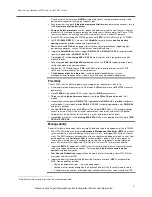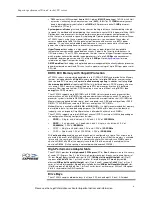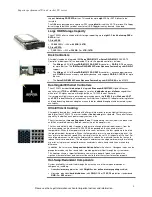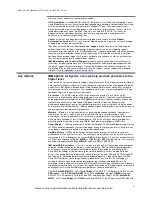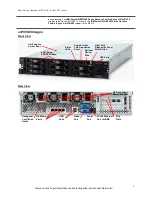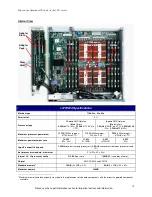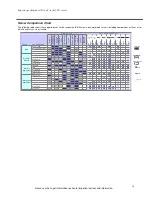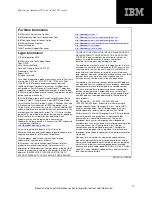
Superior performance/U in a 4-socket, 2U server
Please see the Legal Information section for important notices and information.
5
support
hot-swap
SAS/SATA
drives. This enables up to
eight
SAS or SATA drives to be
installed.
The
fifth
drive bay supports an optional 5.25-inch
optical
drive with a SATA interface. No floppy
drive is supplied with any model; an external USB floppy drive may be used, if needed.
Large HDD Storage Capacity
The x3755 M3 offers a choice of disk storage, supporting up to
eight
3.5
-
inch
hot-swap
SAS
or
SATA
drives:
3.5-inch SAS
•
15,000
RPMs — 300
or
600GB
(
4.8TB
)
3.5-inch SATA
•
7,200
RPMs — 250 or
500GB
,
1
or
2TB
(
16TB
)
Disk Controllers
All models include an integrated IBM
ServeRAID-M1015
or
ServeRAID-M5015
SAS/SATA
Controller (model-specific) in a dedicated PCIe slot. Supported controllers include:
•
The
6Gbps
(x8 PCIe)
ServeRAID-M1015
SAS/SATA
controller —
RAID-0/1/10
(no cache)
for up to
8
drives. The
IBM ServeRAID M1000 Series Advance Feature Key
adds
RAID-5
support.
•
The
6Gbps
(x8 PCIe)
ServeRAID-M5015
SAS/SATA
controller — enhanced performance
with
512MB
of cache memory and battery backup, and supports
RAID-0/1/10/5/50
for up to
8
drives.
•
The
ServeRAID M5000 Series Advance Feature Key
adds
RAID-6/60
to the M5015.
Dual Gigabit Ethernet Controllers
The x3755 M3 includes
two
dual-port
integrated
Broadcom BCM5709C
Gigabit Ethernet
controllers
with
TOE
,
and
RDMA
support, as well as
load-balancing
and
failover
capabilities,
with up to 10X higher maximum throughput than a 10/100 Ethernet controller.
It also supports highly secure remote power management using
IPMI
2.0
, plus
Wake on LAN
®
and
PXE
(Preboot Execution Environment) flash interface. Optional PCI adapters offering failover
and load balancing between adapters are available for added throughput and increased system
availability.
Ultra-Efficient Cooling
Strategically located fans, combined with efficient airflow paths, provide highly effective system
cooling for the x3755 M3. The server includes
five
hot-swap
fans standard. These offer failover
capability. In addition, each power supply contains a fan.
The system contains
two cooling zones
.
Zone 1
(incorporating four fans) cools the processors
and their associated memory.
Zone 2
(one fan) cools the adapter slots.
The fans automatically adjust speeds in response to changing thermal requirements, from the
minimum speed to a maximum of 16,000 RPMs, depending on the zone and internal
temperatures. When the temperature inside the server increases, the fans speed up to maintain
the proper ambient temperature. When the temperature returns to a normal operating level, the
fans return to their default speed. Why not simply run the fans at 100% capacity all the time? For
several good reasons: to reduce the ambient noise, reduce the wear-and-tear on the fans and
reduce the server power draw. The reduction in ambient noise and power draw may be relatively
minor for a single server, but put dozens or hundreds in a data center and it can make a big
difference.
In addition, the server uses
hexagonal ventilation holes
in the chassis. Hexagonal holes can be
grouped more densely than round holes, providing greater airflow through the system cover.
This cooling scheme is important because newer, more powerful processors generate a
significant amount of heat, and heat must be controlled for the system to function properly.
Hot-Swap/Redundant Components
System availability is maximized through the extensive use of hot-swap and redundant
components, including:
•
Redundant
memory
protection (with
Chipkill
and/or
online memory sparing
enabled)
•
Hot-swap, redundant
hard disk drives
(with
RAID-1/10
or
1/10/5/50
protection standard and
RAID-5
or
6/60
optional)


